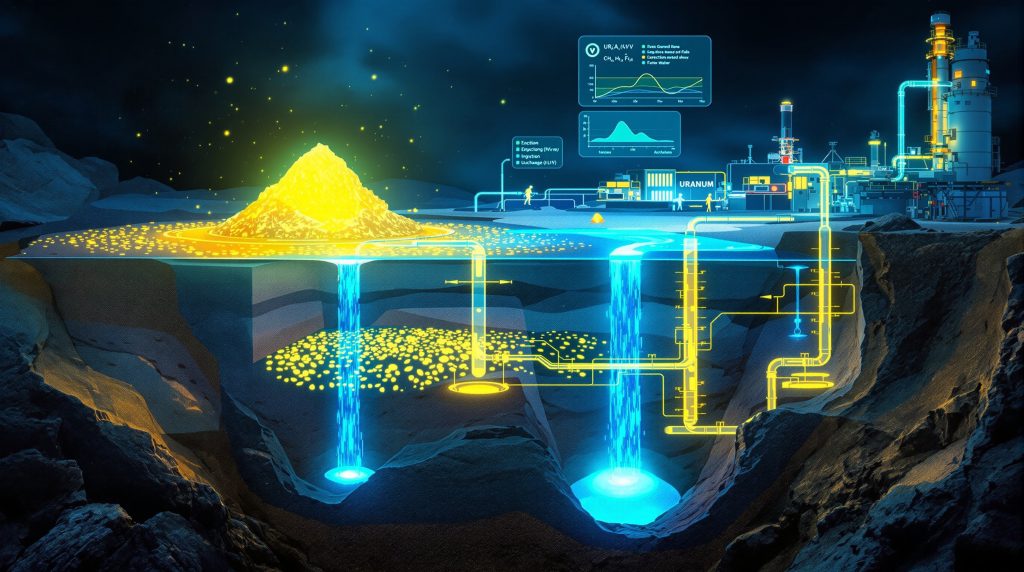What Is In-Situ Leach Uranium Mining?
In-situ leach (ISL) uranium mining represents a transformative approach to extracting uranium that has fundamentally changed global production methods. Unlike conventional mining that physically extracts ore from the ground, ISL works by dissolving uranium directly within its underground deposit, allowing for recovery with minimal surface disruption.
ISL mining accounts for approximately 56% of global uranium production as of 2022, showing remarkable growth from just 13% in the late 1990s. This dramatic shift reflects both the economic and environmental advantages of this innovative extraction method.
How In-Situ Leach Mining Works
The process operates on a straightforward principle: rather than excavating uranium-bearing rock, ISL uses a network of injection and production wells to circulate a leaching solution (lixiviant) through the ore body. This solution dissolves uranium minerals, creating a uranium-rich fluid that is pumped to the surface for processing.
The chemistry involves converting insoluble uranium(IV) compounds to soluble uranium(VI) forms through oxidation reactions. Once mobilized, the uranium can be extracted and concentrated at surface facilities.
Key Components of ISL Operations
- Injection wells: Deliver the leaching solution into the uranium-bearing aquifer
- Production wells: Extract the uranium-rich solution for processing
- Monitoring wells: Track solution movement and detect potential migrations
- Processing facility: Separates uranium via ion exchange processes
- Restoration systems: Work to return groundwater to acceptable conditions after mining
The final product of ISL mining is uranium oxide concentrate (U₃O₈), commonly called "yellowcake," which is dried and packaged for transport to conversion facilities where it continues through the nuclear fuel cycle.
Why Has ISL Become the Dominant Uranium Mining Method?
The remarkable rise of in-situ leach mining from a relatively minor extraction method to the predominant approach worldwide reflects several compelling advantages over conventional mining techniques.
Economic Advantages of ISL Mining
ISL operations typically require significantly lower capital investment than conventional mining approaches. The absence of extensive earthmoving equipment, ore crushing facilities, and massive tailings management systems translates to reduced startup costs—often 50-60% lower than comparable conventional operations.
Operating expenses also tend to be lower, with fewer personnel required and reduced energy consumption. A typical ISL operation may employ 30-50 workers compared to several hundred at a conventional mine of similar production capacity.
The faster development timeline for ISL projects—typically 2-4 years from approval to first production versus 7-10 years for conventional mines—also improves economic performance by allowing quicker response to uranium market volatility.
Environmental Considerations
From a surface perspective, ISL mining creates a substantially smaller footprint than traditional mining:
| Environmental Factor | ISL Mining | Conventional Mining |
|---|---|---|
| Surface disturbance | Minimal (well fields and processing plant) | Extensive (open pits or underground workings) |
| Waste rock production | None | Millions of tonnes |
| Tailings production | Minimal solid waste (~16 tonnes per tonne of uranium) | Extensive (~1,000 tonnes per tonne of uranium) |
| Dust generation | Negligible | Significant |
| Visible landscape impact | Limited to processing facilities | Major landscape alteration |
The reduction in solid waste generation represents one of the most significant environmental advantages. Conventional uranium mining typically produces approximately 1,000 tonnes of tailings for every tonne of uranium extracted, while ISL operations generate only about 16 tonnes of solid waste per tonne of uranium.
Operational Flexibility
ISL operations can be scaled more easily than conventional mines, allowing producers to adjust production levels in response to market conditions. This flexibility has proven particularly valuable in the volatile uranium market of recent decades.
Well fields can be developed sequentially, allowing capital expenditure to be spread over the project life rather than concentrated upfront. Additionally, production can often be increased by simply adding well fields rather than major infrastructure expansions.
Where Is ISL Uranium Mining Currently Practiced?
The geographic distribution of ISL uranium mining is heavily influenced by both geological suitability and regulatory frameworks that enable this specialized extraction method.
Major ISL Uranium Producing Countries
- Kazakhstan: The world's leading uranium producer, contributing approximately 43% of global production (21,227 tonnes U in 2023), with all production via ISL methods
- Australia: Home to significant ISL operations, particularly in South Australia's sandstone basins
- United States: Primarily uses US ISR technology for its remaining uranium production in Wyoming, Nebraska and Texas
- Uzbekistan: A major producer utilizing ISL technology with approximately 3,500 tonnes U production in 2023
- China: Expanding its ISL capabilities to meet growing domestic demand for nuclear fuel
- Russia: Operates several ISL facilities as part of its nuclear fuel cycle
About two-thirds of world uranium production comes from mines in just three countries—Kazakhstan, Canada, and Australia—with Kazakhstan's production entirely from ISL operations.
Geological Requirements for ISL Suitability
Not all uranium deposits are suitable for in-situ leach uranium mining. The technique requires specific geological conditions:
- Permeable host rock: Typically sandstone formations that allow solution flow
- Confined aquifer: Upper and lower impermeable layers (such as clay or shale) to contain the leaching solution
- Appropriate mineralogy: Uranium minerals that dissolve readily in the chosen lixiviant
- Favorable groundwater conditions: Minimal natural flow that could disperse solutions beyond the mining zone
These requirements limit ISL application primarily to sandstone-hosted uranium deposits, which account for approximately 25-30% of world uranium resources. Deposits in granite, volcanic rocks, or unconformity settings typically cannot be mined using ISL techniques.
How Does the ISL Mining Process Work in Detail?
The technical process of in-situ leach mining involves several distinct phases, each critical to successful uranium recovery while maintaining environmental controls.
Site Characterization and Well Field Design
Before mining begins, extensive hydrogeological studies map the uranium deposit and surrounding aquifers. This includes:
- Core sampling to determine uranium content, mineralogy, and host rock permeability
- Pump testing to understand groundwater flow dynamics
- Water quality sampling to establish baseline conditions
- Computer modeling to predict solution movement
Engineers design well patterns based on this data, typically arranging injection wells in patterns around central production wells to create controlled solution flow paths. Common configurations include five-spot patterns (four injection wells surrounding one production well) or seven-spot patterns (six injection wells around one production well).
Leaching Chemistry and Solution Management
The chemistry of ISL mining varies by location:
- Acidic leaching: Primarily used in Kazakhstan, Australia, and Russia, employing sulfuric acid solutions (pH 2-3) with oxidants like hydrogen peroxide or oxygen
- Alkaline leaching: Common in the United States, using sodium bicarbonate or carbon dioxide with oxygen as the oxidant
The leaching solution mobilizes uranium through oxidation reactions, converting insoluble uranium(IV) to soluble uranium(VI) compounds that can be pumped to the surface. These reactions take place within the confined aquifer, with solution typically circulating at rates of 1,500-5,000 gallons per minute.
The entire process operates as a closed loop with approximately 1-3% of circulating solution continuously bled off to maintain hydraulic control of the mining zone.
Uranium Recovery and Processing
Once at the surface, the uranium-bearing solution undergoes:
- Ion exchange: Uranium selectively binds to specialized resins while impurities pass through
- Elution: Uranium is stripped from the resin using a concentrated salt solution
- Precipitation: Chemicals like hydrogen peroxide or ammonia are added to form uranium oxide concentrate
- Drying and packaging: The resulting "yellowcake" (U₃O₈) is dried and packaged for transport
This processing occurs in surface facilities that typically occupy just 50-100 acres, compared to hundreds or thousands of acres for conventional mining operations.
Post-Mining Restoration Approaches
After mining concludes, operators implement restoration strategies:
- Groundwater sweep: Pumping affected water from the aquifer
- Reverse osmosis: Treating extracted water to remove contaminants
- Reductant addition: Chemicals that reverse the oxidation process, helping immobilize metals
- Bioremediation: Using bacteria to convert contaminants to less mobile forms
- Long-term monitoring: Tracking water quality for extended periods, often 5-15 years
Restoration consumes substantial water resources and typically represents 25-40% of total project costs.
What Are the Environmental Concerns Associated with ISL Mining?
While ISL mining offers surface environmental advantages, it raises significant groundwater and aquifer concerns that require careful management and long-term monitoring.
Groundwater Contamination Risks
The most significant environmental concern with in-situ leach uranium mining is potential groundwater contamination. The leaching process deliberately alters groundwater chemistry within the mining zone, introducing:
- Mobilized heavy metals: Including uranium, arsenic, selenium, and molybdenum
- Increased dissolved solids: Affecting water quality
- pH changes: Particularly with acid leaching systems
- Radioactive elements: Including radium and radon
These changes are intentional within the mining zone but must be contained to prevent affecting adjacent aquifers or downgradient water resources.
Challenges in Aquifer Restoration
Complete restoration of mined aquifers to pre-mining conditions has proven challenging:
- Most ISL operations struggle to return all groundwater parameters to baseline conditions
- Regulatory standards often allow for "alternate concentration limits" that exceed pre-mining levels
- Restoration can take decades and consume substantial water resources
- Long-term stability of restored sites remains uncertain
The technical difficulty stems from irreversible changes to aquifer chemistry and physical properties during mining. Once uranium and other metals are mobilized, returning the system to its exact pre-mining state becomes extraordinarily difficult.
Operational Risks and Containment Failures
Potential operational issues include:
- Excursions: Leaching solutions migrating beyond the intended mining zone
- Well casing failures: Creating pathways for solution migration
- Surface spills: From pipelines or processing facilities
- Monitoring limitations: Difficulty detecting subsurface contamination until widespread
Regulatory frameworks require extensive monitoring to detect and address these issues promptly, but perfect containment remains challenging in complex geological environments.
How Is ISL Uranium Mining Regulated?
The regulatory framework for ISL uranium mining varies significantly by country but typically addresses similar concerns related to groundwater protection, radiation safety, and site restoration.
Regulatory Approaches by Region
- United States: Regulated primarily by the Nuclear Regulatory Commission (NRC) or Agreement States, with Environmental Protection Agency (EPA) oversight of groundwater through Underground Injection Control permits
- Australia: State-level regulation with federal oversight for nuclear materials
- Kazakhstan: Centralized regulation through national atomic energy authorities
- European Union: Comprehensive framework addressing both radiation and conventional environmental impacts
These frameworks reflect each region's broader approach to resource development and environmental protection.
Key Regulatory Requirements
Most regulatory frameworks include:
- Detailed hydrogeological characterization: Demonstrating containment potential
- Baseline water quality establishment: Documenting pre-mining conditions
- Monitoring well networks: Detecting potential excursions
- Restoration standards: Defining post-mining water quality targets
- Financial assurance: Guaranteeing funds for cleanup and restoration
- Radiation protection measures: For workers and the environment
The level of stringency varies considerably, with North American and Australian regulations typically requiring more comprehensive baseline data collection, monitoring, and restoration commitments than those in some other regions.
Evolving Regulatory Standards
Regulatory approaches continue to evolve as experience with ISL mining grows:
- Increasing emphasis on long-term monitoring requirements
- More realistic restoration standards based on technical feasibility
- Greater public involvement in permitting decisions
- Enhanced transparency in reporting environmental impacts
Recent regulatory trends focus on risk-based approaches that prioritize protection of usable water resources while acknowledging the technical limitations of complete aquifer restoration.
What Are the Future Trends in ISL Uranium Mining?
The future of in-situ leach uranium mining will be shaped by several emerging trends in technology, markets, and environmental expectations.
Technological Innovations
Ongoing research focuses on:
- Advanced lixiviants: More selective leaching agents that reduce environmental impact
- Real-time monitoring systems: Providing immediate feedback on solution movement
- Enhanced restoration techniques: Including nanotechnology for contaminant removal
- Automation and digitalization: Improving operational efficiency and reducing human error
These innovations aim to address the key challenges of ISL mining: improving recovery efficiency, reducing environmental impact, and enhancing restoration outcomes.
Market and Supply Chain Considerations
ISL mining's future is also influenced by broader nuclear industry dynamics:
- Growing nuclear power demand: Particularly from small modular reactors (SMRs) and advanced reactor designs
- Uranium price volatility: Affecting investment in new projects
- Supply chain security concerns: Driving domestic production in some countries
- ESG (Environmental, Social, Governance) pressures: Demanding improved environmental performance
The geopolitical dimension is increasingly important, as evidenced by recent developments. In 2024, the United States enacted legislation banning imports of Russian-produced low-enriched uranium (LEU) until the end of 2040, with Russia implementing reciprocal export restrictions to the USA. Such developments highlight the strategic importance of domestic uranium resources and production capabilities, potentially leading to more US uranium market disruptions.
Climate Change Implications
The relationship between ISL mining and climate change works in both directions:
- Water scarcity: May limit ISL operations in arid regions as climate change affects water availability
- Carbon footprint: ISL generally has lower emissions than conventional mining
- Nuclear power growth: Increasing demand for uranium as a low-carbon energy source
As countries seek to decarbonize their energy systems, nuclear power—and by extension uranium production—may see increased strategic importance, potentially driving further development of uranium investment strategies.
How Does ISL Compare to Alternative Uranium Mining Methods?
Understanding the relative advantages and disadvantages of different uranium mining approaches provides important context for evaluating ISL's role in the uranium supply chain.
Comparison with Conventional Mining Methods
| Aspect | In-Situ Leach | Open-Pit Mining | Underground Mining |
|---|---|---|---|
| Capital costs | Lower | Higher | Highest |
| Operating costs | Lower | Higher | Higher |
| Production timeline | Faster startup (2-4 years) | Longer development (5-7 years) | Longest development (7-10 years) |
| Surface disturbance | Minimal | Extensive | Moderate |
| Solid waste generation | Minimal | Extensive | Substantial |
| Groundwater impact | Significant | Moderate (unless acid drainage) | Moderate |
| Worker safety | Better | Moderate risks | Higher risks |
| Resource recovery | Lower (50-80%) | Higher (90%+) | Higher (90%+) |
| Ore grade flexibility | Limited to lower grades | Handles variable grades | Best for high grades |
ISL mining typically achieves 50-80% uranium recovery compared to 90%+ recovery rates for conventional open-pit and underground mining methods, but with significantly lower costs and surface disturbance.
Emerging Alternative Approaches
Beyond traditional methods, researchers are exploring:
- Biomining: Using bacteria to extract uranium through biological leaching
- Secondary recovery: Extracting uranium from mine waste or processing residues
- Seawater extraction: Recovering uranium from ocean water (still experimental)
These approaches remain largely in research and development phases, with ISL likely to maintain its dominant position for sandstone-hosted deposits for the foreseeable future.
Appropriate Technology Selection
The choice between mining methods depends primarily on:
- Geological setting: Host rock type, depth, and configuration
- Ore grade: Higher grades typically justify conventional mining costs
- Hydrological conditions: Groundwater characteristics and containment potential
- Regulatory environment: Permitting feasibility for different approaches
- Economic factors: Capital availability and market conditions
No single mining method is universally superior; each has applications where it represents the optimal approach based on site-specific conditions. Recent developments, such as uranium mining halt news from Namibia, show how changing market conditions can affect mining operations regardless of extraction method.
What Questions Should Communities Ask About Proposed ISL Projects?
For communities facing potential ISL uranium development, several key questions deserve consideration to ensure projects are developed responsibly and with appropriate safeguards.
Environmental Due Diligence Questions
- What is the baseline water quality in the area, and how will it be protected?
- What containment features exist to prevent migration of mining solutions?
- What is the track record of the company at similar operations?
- How will restoration success be measured and verified?
- What long-term monitoring will continue after operations cease?
Communities should request comprehensive environmental impact assessments that specifically address groundwater protection measures, excursion detection systems, and restoration plans with clear performance metrics.
Economic Considerations
- How many local jobs will the project create, and what skills are required?
- What is the expected project lifespan?
- What taxes and royalties will benefit local communities?
- What happens when mining concludes?
- What financial assurances exist for cleanup and restoration?
Understanding the full economic cycle—including post-mining transition plans—helps communities evaluate whether the project offers sustainable benefits beyond the operational phase.
Health and Safety Concerns
- What pathways could expose residents to contaminants?
- How will drinking water sources be protected?
- What emergency response plans exist for spills or excursions?
- How will radiation exposure be monitored and limited?
- What independent oversight will verify company compliance?
Communities should seek multiple information sources, including independent technical reviews of company proposals and documented performance at other sites.
FAQs About In-Situ Leach Uranium Mining
Is ISL mining safer than conventional uranium mining?
While ISL mining eliminates many of the physical hazards associated with conventional mining (such as rock falls, heavy equipment accidents, and dust exposure), it introduces different environmental risks, particularly to groundwater. Worker radiation exposure is typically lower in ISL operations, but the potential for long-term environmental impacts remains a significant concern.
ISL operations typically record fewer workplace injuries and lower radiation doses to workers compared to conventional mines. However, safety performance ultimately depends on specific operational practices and management systems.
Can groundwater really be restored after ISL mining?
Complete restoration to pre-mining conditions has proven challenging. While water quality typically improves during restoration efforts, studies indicate that parameters such as uranium, radium, and total dissolved solids often remain elevated above baseline levels. Regulatory frameworks increasingly acknowledge this reality by allowing for "alternate concentration limits" rather than requiring return to baseline conditions.
The technical challenge stems from irreversible geochemical changes in the aquifer during mining. Restoration typically achieves significant improvements in water quality, but returning to exact pre-mining conditions for all parameters has rarely been documented at commercial-scale operations.
How much water does ISL mining use?
Water consumption varies by operation but can be substantial. A typical ISL operation may circulate thousands of gallons per minute through the ore zone. While much of this water is recycled within the process, significant net consumption occurs through:
- Production bleed (removal of some solution to maintain hydraulic control)
- Evaporation losses
- Restoration activities
In arid regions, water consumption can be a limiting factor for ISL development, with some projects requiring dedicated water rights or development of alternative water sources.
Does ISL mining cause radioactive contamination?
ISL mining deliberately mobilizes uranium and, in the process, can also mobilize other naturally occurring radioactive materials such as radium. While these elements are contained within the mining zone during active operations, potential exists for migration beyond the mining area if hydraulic control is lost. Surface facilities handling uranium-bearing solutions must also implement radiation protection measures to prevent contamination.
Proper operational controls and monitoring are essential to detect and mitigate potential contamination pathways.
How long does an ISL operation typically last?
The lifecycle of an ISL operation typically includes:
- 2-4 years for permitting and construction
- 5-10 years of active mining (though some larger deposits may support longer operations)
- 5-15+ years of restoration and monitoring
This timeline makes ISL operations generally shorter-lived than conventional mines but with a potentially longer post-closure monitoring period. Communities should understand this full lifecycle when evaluating project proposals.
Further Exploration
The in-situ leach uranium mining industry continues to evolve with technological innovations, regulatory refinements, and changing market conditions. The nuclear fuel cycle's international dimension means that uranium mined in one country may be processed in several others before fueling reactors worldwide.
While ISL mining offers significant advantages for appropriate deposits, its responsible implementation requires careful attention to site-specific conditions, thorough environmental protections, and comprehensive restoration planning. As with any resource development, stakeholder engagement and transparency throughout the project lifecycle remain essential components of successful operations.
The future of ISL uranium mining will likely see continued refinement of techniques to improve both economic and environmental performance, potentially expanding its application to deposits currently considered unsuitable for in-situ recovery.
Ready to Be Notified About the Next Major Mining Discovery?
Discovery Alert's proprietary Discovery IQ model instantly notifies investors about significant ASX mineral discoveries, delivering actionable insights ahead of the broader market. Explore why historic discoveries can generate substantial returns by visiting the dedicated discoveries page and begin your 30-day free trial today.




